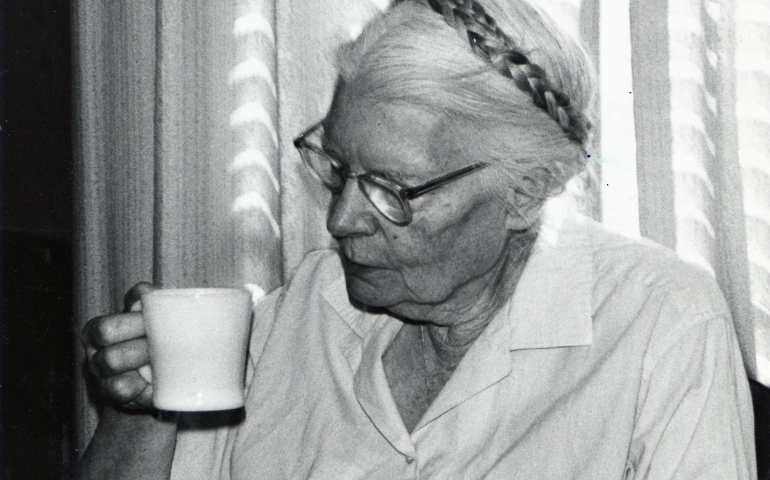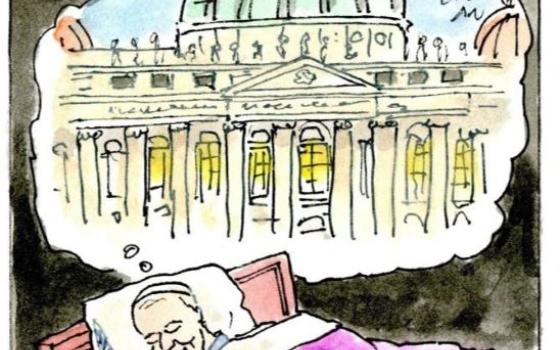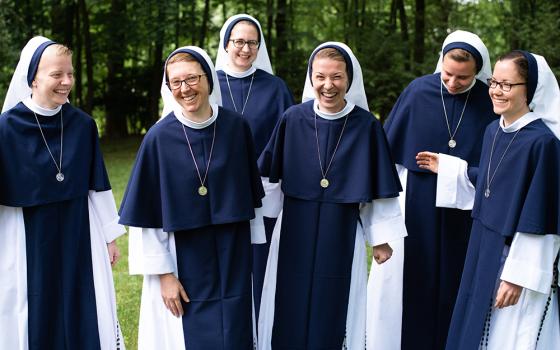
Dorothy Day with a different coffee cup in 1972 (NCR photo)
“All over the world — all the troubled, indeed anguished spots of the world — there Christ is with the poor, the suffering, even in the cup we share together, in the bread we eat.”
—Dorothy Day
Dorothy Day’s biographer Jim Forest tells a story that I first remember hearing at a 1997 conference at Marquette University marking the 100th anniversary of her birth: “When a priest close to the community used a coffee cup for a chalice at a Mass celebrated in the soup kitchen on First Street, she afterward took the cup, kissed it, and buried it in the backyard. It was no longer suited for coffee — it had held the Blood of Christ. I learned more about the Eucharist that day than I had from any book or sermon.”
The story has since taken hold of the imaginations of many. It appears in newspaper articles, blog posts and sermons in various forms. In his telling of the story, published in 1998, Forest charitably presents the celebrant priest as a well-meaning innocent doing as he thought he was expected and who humbly learned from the experience.
In some of the retellings, the priest is exposed as an arrogant and disrespectful upstart acting with evil intent. As Our Sunday Visitor tells it in a 2013 article, for example, he was a “celebrity priest who flouted the Church’s norms.” Always, this story is recounted as the classic illustration of Day’s reverence for the Eucharist and for her adherence to the ritual traditions and regulations of the church.
This story never rang true for me. First, the backyard at St. Joseph House on First Street — where I lived for some years in the 1970s and where the coffee cup is said to have been buried — is a tiny square of broken concrete where the garbage accumulates until pickup day. The “soil” in this backyard is the detritus of coffee grounds, potato peels, broken glass and the composting feces of generations of feral cats. One sermon adds the small detail that Day used “a small gardening tool,” but she would have required a pickaxe, if not a jackhammer, to do the job.
Also, along with many of her generation who lived through the Great Depression, Day had a deep aversion to waste, and it is hard for me to imagine her sacrificing a perfectly good coffee cup to any scruple, no matter how deeply ingrained.
Day’s “On Pilgrimage” column published in The Catholic Worker in March 1966 is often cited as the authority behind this story. “I am afraid I am a traditionalist, in that I do not like to see Mass offered with a large coffee cup as a chalice,” she wrote. While Day did express her discomfort about the use of a cup at a Mass said by a visiting priest, she did not write about burying the cup. By her own report, Day did not actually attend this liturgy herself but only heard about it later: “I was not there when this happened though twenty of the family of the Catholic Workers were there.”
Articles and books about Day often cite her words “I am afraid I am a traditionalist” to summarize and, I think, oversimplify her liturgical sensibilities and her submission to church authority. Day was a radical in issues of war and peace and labor and the distribution of wealth, this narrative goes, but always a traditional Catholic, holding firmly to the rules of the church and especially intolerant of innovations in worship.
I read her words from 1966 differently, and I take Day at her word that she was “afraid” that she was a traditionalist. Far from digging in her heels and making a stand for the old accepted practices, Day was speaking confessionally. She was not boasting of her traditionalism as a virtue, but was admitting a weakness for the familiar that she was not entirely proud of.
Read in context, “I am afraid I am a traditionalist, in that I do not like to see Mass offered with a large coffee cup as a chalice” speaks of a moment of truth, a spiritual growth spurt even so late in her life. While acknowledging her distress over this fracture of the rubrics, Day tells in wonderment of the realization it brought her: “And yet — and yet — perhaps it happened to remind us that the power of God did not rest on all these appurtenances with which we surround it. That all over the world, in the jungles of South America and Vietnam and Africa — all the troubled, indeed anguished spots of the world — there Christ is with the poor, the suffering, even in the cup we share together, in the bread we eat.”
Not a scandal to be buried, the “Coffee Cup Mass” was an epiphany, a revelation and a liberation that Day celebrated with gratitude.
As a Catholic who received his first Communion in 1963, I have vague memories of the changes in the Mass, most notably turning from the use of Latin to English and turning the altar around so the priest faces the people. I remember the resistance of my elders who later grew to accept and even celebrate these innovations as bringing them closer to the God they worshiped. As evidenced in her columns and diary entries, Day was clearly of this number.
Since recently turning 60, I am increasingly aware of what nostalgia means. I find myself apologizing to younger people that I work with for exalting the “good old days” and having to explain that my attachments to the past are not criticisms of the way they are doing things now. I am realizing that I can painfully long for past times and still rejoice in the new and perplexing things popping up all around me.
Some unreformed traditionalists claim Day to their side, citing her nostalgia for the old style of Mass and for the old disciplines of the church. But she could also rejoice in the new, as she wrote in her diary in 1967, “This morning Mass at ten at Good Shepherd chapel at Croton. … The participation of the people is so easy and natural. One cannot conceive of the old silent Masses, often a half hour of dreaming and distraction.”
Likewise, she could talk about missing seeing the nuns in their habits and yet praise the courage of those sisters who could detach themselves from such externals, all without contradiction. “Change may mean growth but it hurts,” she wrote in 1977, and Day had extraordinary courage to embrace change, even at a personal cost.
The common narrative of Day’s lack of enthusiasm for liturgical innovation is further challenged by her diary entry of Jan. 8, 1972, a few years before I knew her: “Allen Ginsberg came in tonight. … Attended Vespers. Ten in the dining room sang mantras, some of which involved us all — Hare Krishna went into Jesus, Mary, then Virgin Mary, then a litany asking prayers for all. … We’ve all sung better since he was here.”
One of those who perpetuated the myth of Day as an unapologetic traditionalist was the late Cardinal John O’Connor, who as archbishop of New York launched the cause for her canonization. “Dorothy Day,” he said in a sermon in 1998, “would not permit a priest to celebrate the Holy Sacrifice of the Mass in one of her houses unless fully vested.”
I was part of the Catholic Worker community in New York for four years up to 1979, the year before Day’s death. During that time, Mass was celebrated at least twice a week by various priests and almost daily for a long stretch when a priest lived with us. Never once did I attend a Mass at our houses celebrated by a “fully vested” priest. Some priests might put on an alb and others not, but even a stole was not a standard requirement. If Day minded this, she never complained about it to my knowledge. She had long before come to understand that “the power of God did not rest on all these appurtenances with which we surround [the Mass],” a truth that it seems the cardinal went to his grave without grasping.
Day’s devotion to the real presence of Christ in the Eucharist cannot be overstated. I remember seeing her spend hours on end in quiet prayer before the Sacrament in the chapel at Mary House and in our neighborhood church. But she was equally devoted to the real presence of Christ in the poor. The lesson on the Eucharist that I learned from Day is that the soup line that served all comers each morning in our kitchen was as sacred a ritual as the Holy Mass. Both at Mass and on the soup line, she taught us, one intimately encounters the divine.
I met Day almost 10 years after this pivotal and fraught “Coffee Cup Mass.” If she had buried a cup in our backyard to keep it from profane use, by my time I don’t believe the event would have raised enough concern to be remembered. I can’t imagine that it would have occurred to anyone present, including Day, to do anything with the cup that had held Christ’s blood than to wash it and reverently return it to the cupboard for sacred use on the next day’s soup line.
That the “Coffee Cup Mass” or something like it happened is not a question. Day wrote of it and about its significance herself. Did she bury that cup in the backyard at First Street? This is highly unlikely. One day archeologists might settle the matter. In response to questions from the Dorothy Day Guild, raised in connection to testimony given in the case for her canonization, Forest has recently clarified that he “didn’t see her actually bury the cup and plate” but only that “she took the cup and plate and said it must be buried.”
Legends always grow up around the lives of heroes and saints, and some of these, even the most fanciful and impossible stories, still can point to and illustrate higher truths. I am afraid, though, that many of those who rejoice to retell the story of the buried cup draw a sharply different lesson from the “Coffee Cup Mass” than Day herself did. Forest also reveals that the “offending” celebrant of this Mass was Jesuit Fr. Daniel Berrigan. It is this beloved friend of Day who has often been so unjustly slandered in the pulpit and the press by those who also distort her message.
If the lesson of this story is not, as some say, that the line between the things that are sacred and those that are profane must never be crossed and that the rules around the sacraments and worship cannot be flouted, then what is it? What is the lesson Day would have us learn?
She often paraphrased and made her own the words of St. John Chrysostom: “If you cannot find Christ in the beggar at the church door, you will not find him in the chalice.” She was also a student of St. Benedict, who in his Rule for monasteries insisted that all of the utensils of the monastery be regarded “as if they were the sacred vessels of the altar.”
What Day learned from the “Coffee Cup Mass” was that the ceramic cup from which the homeless Christ sips her morning coffee is no less holy and no more profane than the gold chalice that holds Christ’s blood in the form of wine at the Mass: “There Christ is with the poor, the suffering, even in the cup we share together, in the bread we eat.”
[Brian Terrell has been a Catholic Worker for more than 40 years.]



